Related Research Articles

Southern Finland was a province of Finland from 1997 to 2009. It bordered the provinces of Western Finland and Eastern Finland. It also bordered the Gulf of Finland and Russia.

Eastern Finland was a province of Finland from 1997 to 2009. It bordered the provinces of Oulu, Western Finland and Southern Finland. It also bordered Russia to the east.
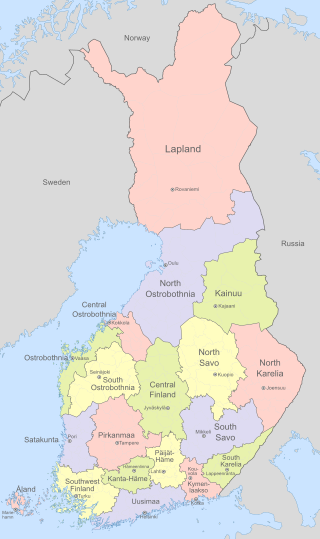
Finland is divided into 19 regions which are governed by regional councils that serve as forums of cooperation for the municipalities of each region. The councils are composed of delegates from the municipal councils. The main tasks of regional councils are regional planning, the development of enterprises, and education. Between 2004 and 2012, the regional council of Kainuu was elected via popular elections as part of an experimental regional administration.

Joensuu is a city in Finland and the regional capital of North Karelia. It is located in the eastern interior of the country and in the Finnish Lakeland. The population of Joensuu is approximately 78,000, while the sub-region has a population of approximately 127,000. It is the 12th most populous municipality in Finland, and the ninth most populous urban area in the country.
The former Province of Eastern Finland in Finland was divided into three regions, 11 districts and 49 municipalities.

Karelians are a Baltic Finnic ethnic group who are indigenous to the historical region of Karelia, which is today split between Finland and Russia. Karelians living in Russian Karelia are considered a distinct ethnic group closely related to Finnish Karelians, who are considered a subset of Finns. This distinction historically arose from Karelia having been fought over and eventually split between Sweden and Novgorod, resulting in Karelians being under different cultural spheres.

Karelia is a historical province of Finland, consisting of the modern-day Finnish regions of South Karelia and North Karelia plus the historical regions of Ladoga Karelia and the Karelian isthmus, which are now in Russia. Historical Karelia also extends to the regions of Kymenlaakso, Northern Savonia and Southern Savonia (Mäntyharju).

North Karelia is a region in eastern Finland. It borders the regions of Kainuu, North Savo, South Savo and South Karelia, as well as Russia's Republic of Karelia. It is the easternmost region of Finland and shares a 300 kilometres (190 mi) border with Russia. The city of Joensuu is the capital and the largest settlement of the region.
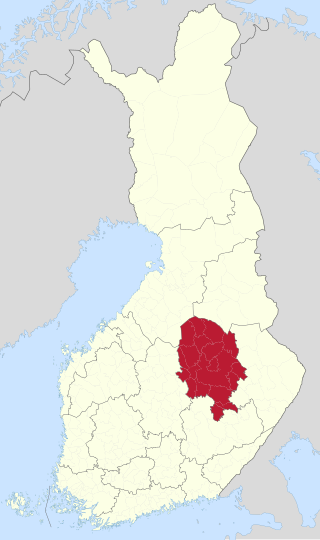
North Savo is a region in eastern Finland. It borders the regions of South Savo, Central Finland, North Ostrobothnia, Kainuu, and North Karelia. Kuopio is the largest city in the region and Lake Kallavesi is the largest lake in the region.
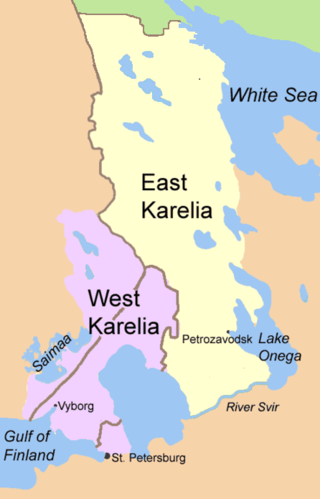
East Karelia, also rendered as Eastern Karelia or Russian Karelia, is a name for the part of Karelia that since the Treaty of Stolbovo in 1617 has remained Eastern Orthodox and a part of Russia. It is separate from the western part of Karelia, called Finnish Karelia or historically Swedish Karelia. Most of East Karelia has become part of the Republic of Karelia within the Russian Federation. It consists mainly of the old historical regions of Viena Karjala and Aunus Karjala.
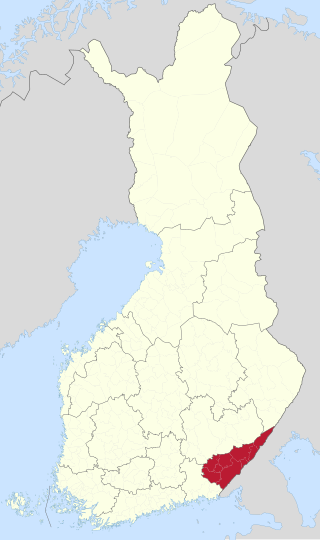
South Karelia is a region of Finland. It borders the regions of Kymenlaakso, South Savo and North Karelia, as well as Russia.

Karelia is an area in Northern Europe of historical significance for Russia, Finland, and Sweden. It is currently divided between northwestern Russia and Finland.
Sub-regions are divisions used for statistical purposes in Finland. The country is divided into 69 sub-regions, which are formed by groups of municipalities within the 19 regions of Finland. These sub-regions represent a LAU 1 level of division used in conjunction with the Nomenclature of Territorial Units for Statistics.

South Savo is a region in the south-east of Finland. It borders the regions of North Savo, North Karelia, South Karelia, Kymenlaakso, Päijät-Häme, and Central Finland. The total area of South Savo is 18,768.33 km2, with a population of 153,738 (2011). South Savo is located in the heart of the Finnish lake district, and contains Lake Saimaa, the largest lake in Finland. The three major towns in the region are Mikkeli, Savonlinna and Pieksämäki.
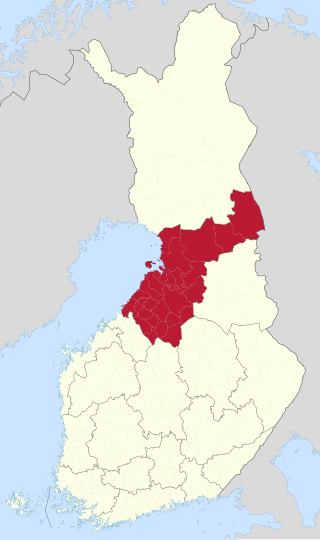
North Ostrobothnia is a region of Finland. It borders the Finnish regions of Lapland, Kainuu, North Savo, Central Finland and Central Ostrobothnia, as well as the Russian Republic of Karelia. The easternmost corner of the region between Lapland, Kainuu and the Russian border is known as Koillismaa.

Heinävesi is a municipality of Finland. It is located in the North Karelia region. The municipality has a population of 3,001 and covers an area of 1,319.58 square kilometres (509.49 sq mi) of which 288.71 km2 (111.47 sq mi) is water. The population density is 2.91 inhabitants per square kilometre (7.5/sq mi). Neighbouring municipalities are Savonlinna, Varkaus, Leppävirta, Tuusniemi, Outokumpu and Liperi. The city of Joensuu is located 81 kilometres (50 mi) northeast of Heinävesi. The municipality is unilingually Finnish.

Greater Finland, was an irredentist and nationalist idea that was a subset of Pan-Finnicism which emphasized the territorial expansion of Finland. The most common concept of Greater Finland saw the country as defined by natural borders encompassing the territories inhabited by Finns and Karelians, ranging from the White Sea to Lake Onega and along the Svir River and Neva River—or, more modestly, the Sestra River—to the Gulf of Finland. Some proponents also included the Torne Valley, Ingria, and Estonia.
There are 13 electoral districts for elections to the Finnish Parliament. Each electoral district elects a number of MPs proportional to its population, currently ranging from 6 to 35 MPs, except Åland which only elects one.

Russia, the largest country in the world, has international land borders with fourteen sovereign states as well as 2 narrow maritime boundaries with the United States and Japan. There are also two breakaway states bordering Russia, namely Abkhazia and South Ossetia. The country has an internationally recognized land border running 22,407 kilometres (13,923 mi) in total, and has the second-longest land border of any country in the world, after China. The borders of the Russian Federation were mostly drawn since 1956, and have remained the same after the dissolution of the Soviet Union. In 2014, Russia annexed Ukraine's Crimean peninsula in a move that remains internationally unrecognized.
Karelians, also known as Finnish Karelians or Karelian Finns, are a subgroup of the Finnish people, traditionally living in Finnish Karelia. Karelians speak eastern dialects of the Finnish language: the South Karelian dialects are spoken in South Karelia, while the eastern Savonian dialects are spoken in North Karelia. The South Karelian dialects were spoken in the Karelian Isthmus prior to the Winter War. Karelians are traditionally Lutheran Christians, with an Orthodox Christian minority, belonging to either the Evangelical Lutheran Church of Finland or the Orthodox Church of Finland respectively.
References
- ↑ "Government decided on division into regions" . Retrieved 1 Jan 2021.
